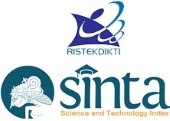Pengaruh Tingkat Keamanan, Kenyamanan dan Produk Wisata terhadap Sustainable Tourism di Ponorogo
Abstract
ABSTRACT
Ponorogo Regency has 21 sub-districts with a population of 949,320 people, and also has quite a lot of tourism potential. In 2022, there will be 312 tourist locations spread across 21 sub-districts. This tourism potential is certainly a potential that must be developed to encourage economic growth in the community. The aim of this research is to test and analyze the influence of the level of security, comfort and tourism products on sustainable tourism in Ponorogo. The population of this study were tourists visiting the Ponorogo area, with a sample size of 100 people. The analysis technique used in this research is multiple linear regression analysis with the help of SPSS software. These results prove that sustainable tourism in Ponorogo Regency is significantly influenced by the level of security, comfort and tourism products.
ABSTRAK
Kabupaten Ponorogo memiliki 21 kecamatan dengan jumlah penduduk 949.320 jiwa, dan juga memiliki potensi pariwisata yang cukup banyak. Pada tahun 2022 nanti akan terdapat 312 lokasi wisata yang tersebar di 21 kecamatan. Potensi pariwisata tersebut tentunya menjadi potensi yang harus dikembangkan untuk mendorong pertumbuhan ekonomi masyarakat. Tujuan dari penelitian ini adalah untuk menguji dan menganalisis pengaruh tingkat keamanan, kenyamanan dan produk wisata terhadap pariwisata berkelanjutan di Ponorogo. Populasi penelitian ini adalah wisatawan yang berkunjung ke daerah Ponorogo, dengan jumlah sampel sebanyak 100 orang. Teknik analisis yang digunakan dalam penelitian ini adalah analisis regresi linier berganda dengan bantuan software SPSS. Hasil tersebut membuktikan bahwa pariwisata berkelanjutan di Kabupaten Ponorogo dipengaruhi secara signifikan oleh tingkat keamanan, kenyamanan dan produk wisata.
Keywords
Full Text:
PDFReferences
Adiati, & Basalamah. (2014). Kondisi pariwisata berkelanjutan dibidang sosial budaya berdasar pengalaman dan harapan pengunjung di Pantai Tanjung Papuma, Jember. Binus Businesss Review, 5(1), 80–90.
Aslan, H. (2023). The influence of halal awareness, halal certificate, subjective norms, perceived behavioral control, attitude and trust on purchase intention of culinary products among Muslim costumers in Turkey. International Journal of Gastronomy and Food Science, 32(April), 100726.
Darma, I. G. K. I. P., Dewi, M. I. K., & Rai, N. M. (2020). Community movement of waste use to keep the image of tourism industry in Gianyar. Journal of Indonesian Tourism, Hospitality and Recreation, 3(1), 49–57.
Darsono, K., & Bahri, A. S. (2020). Analisis motivasi pelanggan datang ke fun world central park Jakarta Barat. Journal FAME: Journal Food and Beverage, Product and Services, Accomodation Industry, Entertainment Services, 2(2).
Di-Vaio, A., López-Ojeda, A., Manrique-de-Lara-Peñate, C., & Trujillo, L. (2022). The measurement of sustainable behaviour and satisfaction with services in cruise tourism experiences. An empirical analysis. Research in Transportation Business and Management, 45(May 2020).
Elim, Y. V., Istiqlaal, S., & Modena, A. P. (2019). Perumusan Indeks Penilaian 5A (Attraction, Accessibilities, Amenities, Accommodation dan Awareness) untuk obyek Wisata Pantai Lasiana Kupang Provinsi NTT, Flobamora, 2(2), 20-38.
Farnad Pour, A. D. (2016). The Application of Fuzzy Delphi Method (FDM) for evaluating the factors affecting sustainable tourism in order to develop a model for sustainable tourism. IOSR Journal of Business and Management, 18(09), 23–29.
Guan, J., Chan, J. H., Bi, J., & Qi, X. (2022). Cultural proximity, destination familiarity and tourists’ sense of away-from-home (SAFH). Journal of Destination Marketing and Management, 23(February 2020), 100670.
He, M., Tu, J., Li, Y., Fang, J., & Zeng, X. (2024). Tourist preference for tourism product brand biographies. Annals of Tourism Research, 107, 103773.
Juliana, J., & Sitorus, N. B. (2022). Kelengkapan produk wisata di Pulau Siladen sebagai destinasi wisata Bahari. Khasanah Ilmu-Jurnal Pariwisata dan Budaya, 13(1), 26-37.
Li, Y., Liu, Y., & Solangi, Y. A. (2024). Analysis of factors and strategies for the implementation of sustainable tourism in a green economic structure in China. Journal of Cleaner Production, 434 (November 2023), 140011.
Lloret, J., Carreño, A., Carić, H., San, J., & Fleming, L. E. (2021). Environmental and human health impacts of cruise tourism: A review. Marine Pollution Bulletin, 173(September).
Melkonyan, A., Gruchmann, T., Lohmar, F., & Bleischwitz, R. (2022). Decision support for sustainable urban mobility: A case study of the Rhine-Ruhr area. Sustainable Cities and Society, 80(March), 103806.
Munawar, R. (2022). Keseimbangan harga dan kualitas produk wisata di destinasi Batukaras Pangandaran menurut wisatawan. Journal of Indonesian Tourism, Hospitality and Recreation, 5(2), 155–168.
Nag, A., & Sarkar, S. (2024). Integrating choice freedom, economic health, and transportation infrastructure to forecast tourism demand: A case study of Bishnupur and its alignment with sustainable development goals. Transport Policy, 147(May 2023), 198-214.
Nurazizah, G. R., & Marhanah, S. (2020). Influence of destination image and travel experience towards revisit intention in Yogyakarta as tourist destination. Journal of Indonesian Tourism, Hospitality and Recreation, 3(1), 28–39.
Prima, F. (2021). Strategi pengembangan industri pariwisata di Kabupaten Sanggau. UNIPLAN: Journal of Urban and Regional Planning, 2(1), 17–28.
Safitri, I., Ramdan, A. M., & Sunarya, E. (2020). Peran produk wisata dan citra destinasi terhadap keputusan berkunjung wisatawan. Jurnal Ilmu Manajemen, 8(3), 734.
Saragih, Y. S. (2023). Analysis of the effect of tourism development on tourist satisfaction in the Bukit Indah Simarjarunjung tourism area, Pariksabungan Village, Simalungun Regency. Jurnal Ekonomi dan Bisnis Digital, 2(1), 115–134.
Sianipar, R. E. P. (2022). Pengaruh tingkat keamanan dan kenyamanan terhadap pariwisata TALENTA conference series keragaman budaya dan struktur spasial dalam konteks Kecamatan. Talenta Conference Series, 5(1), 354–358.
Sidabutar, D. K., & Hidayat, R. (2023). Pengaruh pengelolaan lingkungan dan kenyamanan terhadap kepuasan wisatawan di Kampung Wisata Sawah. Ekonomi, Keuangan, Investasi dan Syariah (EKUITAS), 4(4), 1207–1212.
Suta, P. W. P., & Mahagangga, I. G. A. O. (2018). Pengembangan pariwisata berbasis masyarakat. Jurnal Destinasi Pariwisata, 5(1), 144–154.
Tok, D., Huang, Y., & Yang, L. (2024). “Feel the green”: How a handwritten typeface affects tourists’ responses to green tourism products and services. Tourism Management, 104(May 2023), 104920.
Waruwu, M. (2023). Pendekatan penelitian pendidikan: Metode penelitian kualitatif, Metode penelitian kuantitatif dan Metode penelitian kombinasi (Mixed Method). Jurnal Pendidikan Tambusai , 7(1), 2896–2910.
Yuniar, N., & Indratno, I. (2022). Pengukuran motivasi masyarakat terhadap keberlangsungan ekologi di Desa Wisata Rawabogo berbasis Neurosains. Jurnal Riset Perencanaan Wilayah dan Kota, 91–100.
Zhou, H., Chi, X., Norman, R., Zhang, Y., & Song, C. (2024). Tourists’ urban travel modes: Choices for enhanced transport and environmental sustainability. Transportation Research Part D: Transport and Environment, 129(September 2023), 104144.
DOI: https://doi.org/10.17509/jithor.v7i2.71828
Refbacks

This work is licensed under a Creative Commons Attribution-ShareAlike 4.0 International License.
eISSN : 2654-4687
pISSN : 2654-3893
This work is licensed under Creative Commons Attribution-ShareAlike 4.0 International License














